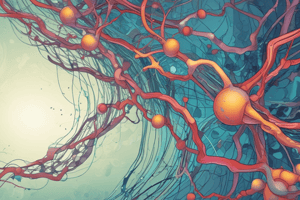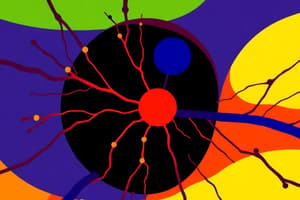Podcast
Questions and Answers
What is the thickness of microtubules?
What is the thickness of microtubules?
- 50 nm
- 25 nm (correct)
- 5 nm
- 10 nm
What are microtubules composed of?
What are microtubules composed of?
- Subunits of DNA
- Subunits of lipid molecules
- Subunits of carbohydrates
- Subunits of globular protein tubulin (correct)
How many protofilaments typically form a microtubule?
How many protofilaments typically form a microtubule?
- 20
- 15
- 13 (correct)
- 10
Which type of tubulin is involved in polymerization and organization of microtubules in the cell?
Which type of tubulin is involved in polymerization and organization of microtubules in the cell?
What gives the structure of a microtubule polarity?
What gives the structure of a microtubule polarity?
How many protofilaments contact laterally to form a microtubule?
How many protofilaments contact laterally to form a microtubule?
What type of tubulin binds GTP reversibly and can be hydrolyzed to GDP?
What type of tubulin binds GTP reversibly and can be hydrolyzed to GDP?
What drives the polymerization and depolymerization of microtubules?
What drives the polymerization and depolymerization of microtubules?
What type of tubulin is exposed at the minus end of a microtubule?
What type of tubulin is exposed at the minus end of a microtubule?
How does the length of microtubules change?
How does the length of microtubules change?
What does the myosin head hydrolyze ATP into?
What does the myosin head hydrolyze ATP into?
What happens when the myosin head binds to actin?
What happens when the myosin head binds to actin?
What is the role of kinesins and dyneins during interphase?
What is the role of kinesins and dyneins during interphase?
What is responsible for the movement of cilia and flagella?
What is responsible for the movement of cilia and flagella?
What is the result of myosin head hydrolyzing ATP?
What is the result of myosin head hydrolyzing ATP?
What occurs when the myosin head is in a low-energy configuration?
What occurs when the myosin head is in a low-energy configuration?
What moves towards the center of the sarcomere during muscle contraction?
What moves towards the center of the sarcomere during muscle contraction?
What is involved in the sliding of microtubules against each other?
What is involved in the sliding of microtubules against each other?
What is the role of dyneins during cell division?
What is the role of dyneins during cell division?
What is responsible for intracellular transport during interphase?
What is responsible for intracellular transport during interphase?
What is the process called when one end of a microtubule polymerises while the other end disassembles?
What is the process called when one end of a microtubule polymerises while the other end disassembles?
Which structure serves as nucleation sites for microtubule assembly?
Which structure serves as nucleation sites for microtubule assembly?
What are the hair-like cell appendages formed by microtubules and surrounded by a membrane called?
What are the hair-like cell appendages formed by microtubules and surrounded by a membrane called?
Which molecular motors move toward the plus end of microtubules?
Which molecular motors move toward the plus end of microtubules?
What is the role of basal bodies in cell structures?
What is the role of basal bodies in cell structures?
What is the term for the process of changing chemical energy into mechanical energy and transporting cell structures along microtubules?
What is the term for the process of changing chemical energy into mechanical energy and transporting cell structures along microtubules?
What determines the rate of microtubule polymerisation?
What determines the rate of microtubule polymerisation?
What type of movement do dyneins exhibit along microtubules?
What type of movement do dyneins exhibit along microtubules?
What is the term for the phase in which microtubules form in vitro?
What is the term for the phase in which microtubules form in vitro?
Which motor movement consists of filament binding, conformational change, filament release, and conformational relaxation?
Which motor movement consists of filament binding, conformational change, filament release, and conformational relaxation?
What gives the structure of a microtubule polarity?
What gives the structure of a microtubule polarity?
What type of tubulin binds GTP reversibly and can be hydrolyzed to GDP?
What type of tubulin binds GTP reversibly and can be hydrolyzed to GDP?
How many protofilaments typically form a microtubule?
How many protofilaments typically form a microtubule?
What is the role of y-tubulin in microtubule organization?
What is the role of y-tubulin in microtubule organization?
What is the term for the process of changing chemical energy into mechanical energy and transporting cell structures along microtubules?
What is the term for the process of changing chemical energy into mechanical energy and transporting cell structures along microtubules?
What drives the depolymerization of microtubules?
What drives the depolymerization of microtubules?
What is the term for the phase in which microtubules form in vitro?
What is the term for the phase in which microtubules form in vitro?
What are microtubules composed of?
What are microtubules composed of?
What occurs when the myosin head binds to actin?
What occurs when the myosin head binds to actin?
What is the thickness of microtubules?
What is the thickness of microtubules?
What is the result of myosin head hydrolyzing ATP?
What is the result of myosin head hydrolyzing ATP?
What occurs when the myosin head binds to actin?
What occurs when the myosin head binds to actin?
Which motor movement consists of filament binding, conformational change, filament release, and conformational relaxation?
Which motor movement consists of filament binding, conformational change, filament release, and conformational relaxation?
What are molecular motors involved in?
What are molecular motors involved in?
During interphase, what are kinesins and dyneins involved in?
During interphase, what are kinesins and dyneins involved in?
What is responsible for the movement of cilia and flagella?
What is responsible for the movement of cilia and flagella?
What drives the polymerization and depolymerization of microtubules?
What drives the polymerization and depolymerization of microtubules?
What is the term for the process of changing chemical energy into mechanical energy and transporting cell structures along microtubules?
What is the term for the process of changing chemical energy into mechanical energy and transporting cell structures along microtubules?
What type of tubulin binds GTP reversibly and can be hydrolyzed to GDP?
What type of tubulin binds GTP reversibly and can be hydrolyzed to GDP?
What is the role of basal bodies in cell structures?
What is the role of basal bodies in cell structures?
What is the term for the process in which one end of a microtubule polymerises while the other end disassembles?
What is the term for the process in which one end of a microtubule polymerises while the other end disassembles?
What determines the rate of microtubule polymerisation?
What determines the rate of microtubule polymerisation?
What are the hair-like cell appendages formed by microtubules and surrounded by a membrane called?
What are the hair-like cell appendages formed by microtubules and surrounded by a membrane called?
Which molecular motors move toward the plus end of microtubules?
Which molecular motors move toward the plus end of microtubules?
What is the term for microtubule nucleation and organisation sites within the cell?
What is the term for microtubule nucleation and organisation sites within the cell?
What is involved in the formation of flagella and cilia?
What is involved in the formation of flagella and cilia?
What type of movement do dyneins exhibit along microtubules?
What type of movement do dyneins exhibit along microtubules?
What is the term for the process of changing chemical energy into mechanical energy and transporting cell structures along microtubules?
What is the term for the process of changing chemical energy into mechanical energy and transporting cell structures along microtubules?
Study Notes
Microtubules and Molecular Motors: Key Concepts
- Microtubules exhibit dynamic instability, with different rates of polymerisation and depolymerisation at their plus and minus ends.
- Treadmilling occurs when one end of a microtubule polymerises while the other end disassembles.
- The rate of microtubule polymerisation is dependent on the critical concentration of alpha-tubulin.
- Microtubules form in vitro through three phases: lag phase, growth phase, and steady state phase.
- Microtubule-organising centres (MTOCs) such as centrosomes and basal bodies play a central role in microtubule nucleation and organisation.
- Centrosomes contain centrioles and pericentriolar material, serving as nucleation sites for microtubule assembly.
- Basal bodies, formed from centrioles, are involved in the formation of flagella and cilia.
- Cilia and flagella are hair-like cell appendages formed by microtubules and surrounded by a membrane, with cilia being more numerous and shorter.
- Molecular motors, such as kinesins and dyneins, can change chemical energy into mechanical energy and transport cell structures along microtubules.
- Kinesins move toward the plus end of microtubules, while dyneins move toward the minus end.
- Molecular motors associated with microfilaments are myosins, which move toward the plus end.
- The motor movement consists of four steps: filament binding, conformational change, filament release, and conformational relaxation.
Microtubules and Molecular Motors: Key Concepts
- Microtubules exhibit dynamic instability, with different rates of polymerisation and depolymerisation at their plus and minus ends.
- Treadmilling occurs when one end of a microtubule polymerises while the other end disassembles.
- The rate of microtubule polymerisation is dependent on the critical concentration of alpha-tubulin.
- Microtubules form in vitro through three phases: lag phase, growth phase, and steady state phase.
- Microtubule-organising centres (MTOCs) such as centrosomes and basal bodies play a central role in microtubule nucleation and organisation.
- Centrosomes contain centrioles and pericentriolar material, serving as nucleation sites for microtubule assembly.
- Basal bodies, formed from centrioles, are involved in the formation of flagella and cilia.
- Cilia and flagella are hair-like cell appendages formed by microtubules and surrounded by a membrane, with cilia being more numerous and shorter.
- Molecular motors, such as kinesins and dyneins, can change chemical energy into mechanical energy and transport cell structures along microtubules.
- Kinesins move toward the plus end of microtubules, while dyneins move toward the minus end.
- Molecular motors associated with microfilaments are myosins, which move toward the plus end.
- The motor movement consists of four steps: filament binding, conformational change, filament release, and conformational relaxation.
Studying That Suits You
Use AI to generate personalized quizzes and flashcards to suit your learning preferences.
Description
Test your knowledge of microtubules and molecular motors with this quiz. Explore key concepts such as dynamic instability, treadmilling, microtubule polymerisation, MTOCs, and the functions of molecular motors like kinesins, dyneins, and myosins.




